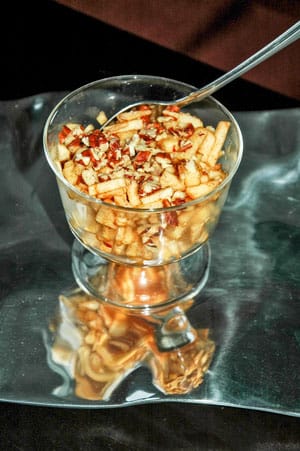Passover charoset for your springtime table


Article and photo by Lisa Crockett
Every once in a while, I get curious about how other cultures express their traditions in the kitchen. To satisfy that curiosity, I have made my fair share of globe-spanning tidbits. Though I do not generally have these exotic dishes as part of my regular dinnertime rotation, I have been known to whip up a batch of potstickers from scratch, slave over pillowy homemade gnocchi, and pull a respectable babka from my oven. As I have begun to plan my Easter menu for this year, I got curious about what people might be putting on their tables for the observance of Passover, a holiday I have only rudimentary knowledge of.
Many years ago (I was a teenager,) I was honored to be invited to a Passover seder at a local synagogue, where the rabbi explained the significance of all the dishes served. The details of that evening are lost in the recesses of my memory, but I do remember it being quite fascinating. I decided to do a little research and introduce at least a few of the ideas of the feast of the Passover at my own dinner table one evening. Passover celebrates the exodus of the Jews from their enslavement in Egypt, and much of the meal symbolizes the hardships the Jews endured – salt water to symbolize tears, broken matzah to symbolize the parting of the Red Sea, and an empty place set at the table reserved for the prophet Elijah. As I researched the traditions of the meal, I ran across a tempting component of the meal called charoset.
I whipped up a quick batch of the fruity side dish from ingredients in my fridge and pantry. Apparently, the apple dish was popular in ancient Palestine, and for the purposes of Passover, came to represent the mortar of the bricks Jewish slaves were forced to lay for their Egyptian masters. I explained this to my children over dinner, while I served it to them as part of a regular weeknight meal. My explanation likely fell on deaf ears, however, since they were so busy shoveling it into their mouths and asking for second and third helpings. This dish, unlike so many other exotic offerings I’ve tried, is likely to become a regular part of our menu at home. It is fairly nutritious, tastes delicious, and comes together in a flash.
Some versions of charoset are rumored to have 40 ingredients (to symbolize 40 years in the desert), but most recipes I encountered were much simpler than that. In all of them, peeled, finely chopped or pureed apples are mixed with nuts, spices and wine to make a zesty, fresh-tasting compote. For Passover, kosher-for-Passover wine is used, and some versions include ground matzah for thickening. I was happy to note that the variations on the dish were virtually endless, and since my pantry was lacking in a few of the more traditional components, I improvised with things I had on hand. For instance, I didn’t have any kosher wine, so I subbed in a deliciously sweet and tangy balsamic vinegar I had bought at a specialty store on a whim and had been saving for a special occasion. In addition to the traditional cinnamon, I added a dash of cardamom to add a different dimension to the dish’s flavor. Walnuts are usually used, but I like pecans better, so that is what landed in my dish. The next time I make charoset, which will be soon, I think I will add a diced pear and a handful of golden raisins.
Charoset is often used to top matzah, but at our table it was a delicious accompaniment for chicken. After the meal ended, my kids ate the leftovers as a bedtime snack and groaned with disappointment when the last spoonful was eaten. Lucky for them, it is so easy to make that I have adopted it as a regular to our mealtimes, so it will show up again and again. I may even serve it as part of our Easter dinner as a nod to the things so many cultures share: good food, holiday traditions, and the hope that comes with the arrival of spring.
Charoset
3-4 large apples, any variety, peeled and chopped (to equal about three cups)
1/4 cup honey
2 tablespoons balsamic vinegar
1/2 teaspoon cinnamon
1/4 teaspoon cardamom
1/2 cup chopped pecans
Mix apples with honey, vinegar and spices, stir well. Let mixture sit for five minutes to allow flavors to blend. Gently stir in nuts and serve immediately.